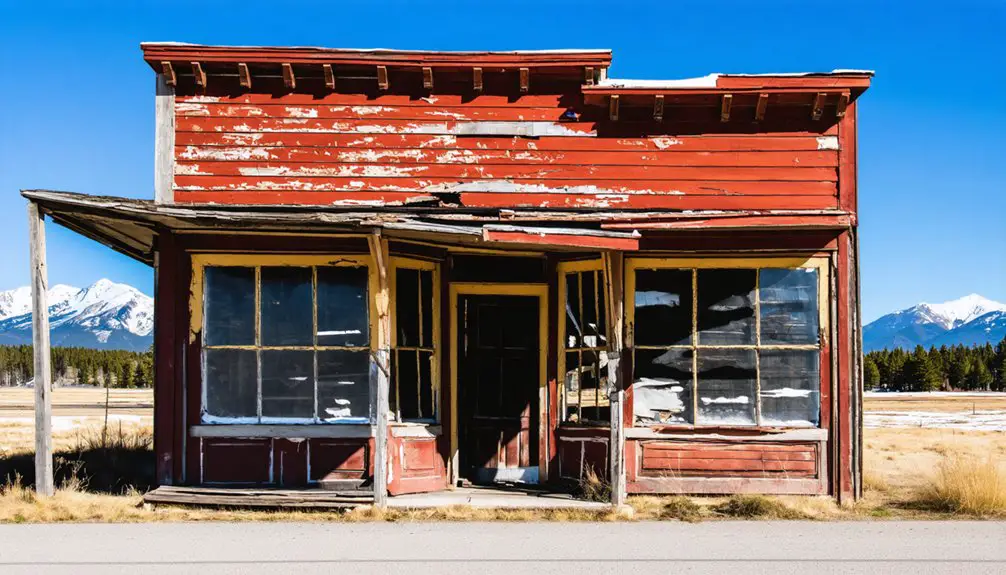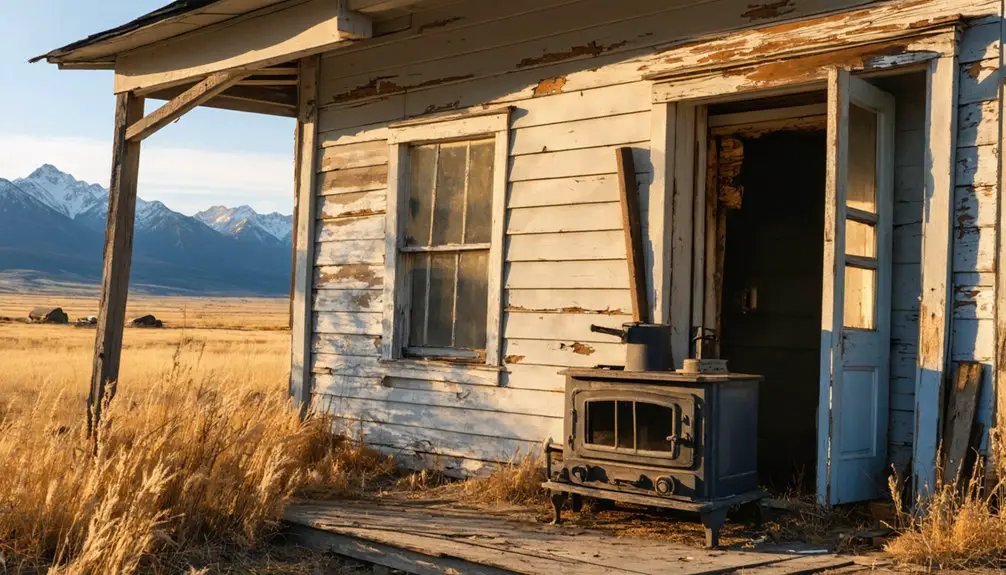You’ll find Marysville tucked away in Montana’s mountains, where Tommy Cruse’s 1876 gold discovery sparked one of the territory’s last great rushes. At its peak, this boomtown boasted 4,000 residents, 60 businesses, and produced $60 million in precious metals from the legendary Drumlummon Mine. After decades of decline, fires, and the 1925 railroad removal, it transformed into a ghost town. The historic buildings and mining ruins still whisper tales of Montana’s golden age.
Key Takeaways
- Marysville grew from a gold discovery in 1876 to a bustling town of 4,000 residents before declining into a near-ghost town.
- The Drumlummon Mine produced over 1.3 million metric tons of ore until 1952, generating $60 million in precious metals.
- The town’s decline began after its mine ownership changed hands, followed by a devastating 1910 fire and railroad removal in 1925.
- World War II’s ban on gold mining reduced Marysville’s population to just 80 residents from its peak of 5,500.
- Historic buildings remain, including the 1886 Methodist-Episcopal Church and Pioneer Memorial Building, now protected by preservation efforts.
The Gold Rush That Built a Boomtown
When Tommy Cruse discovered a rich gold vein along Silver Creek in 1876, he couldn’t have known his find would spark one of Montana Territory’s last great gold rushes.
As you follow his journey upstream from placer mining to golden discoveries at what became the Drumlummon Mine, you’ll see how one man’s persistence transformed a wilderness into a thriving boomtown named after Mary Ralston, its first female resident.
The district’s rapid growth showcased the evolution of mining technology, as Cruse built a five-stamp mill to process the abundant ore. The area reached its peak with 4,000 residents during the height of mining operations.
By 1881, you’d have found a bustling post office and numerous businesses in Marysville. The town grew to include twenty-seven saloons and multiple hotels during its peak.
The Drumlummon’s early yield of $140,000 was just the beginning – the mine would eventually produce half of the district’s staggering $50-60 million output.
Tommy Cruse and the Legendary Drumlummon Mine
You’ll find few stories more compelling than Tommy Cruse’s journey from penniless Irish immigrant to millionaire mine owner in Montana Territory.
After borrowing money to develop his 1876 gold discovery on Silver Creek, Cruse’s Drumlummon Mine yielded an impressive $140,000 in initial ore, validating his persistence despite earlier ridicule from fellow miners.
His fortunes soared even higher when he sold the operation to English investors in 1884 for $1.5 million in cash and stock, transforming him from a struggling prospector into one of Helena’s most prominent businessmen. The transaction with the Montana Mining Company would allow Cruse to maintain a one-sixth ownership stake in the operation.
The mine would continue operating until 1952, producing over 1.3 million metric tons of ore throughout its lifetime.
From Rags to Riches
The remarkable tale of Tommy Cruse embodies the quintessential American dream of the mining frontier.
You’ll find his immigrant struggles evident in his early days as a broke placer miner on Silver Creek, where he’d to borrow money just to work his claim.
Born in County Cavan, Ireland, Cruse immigrated to America seeking better opportunities in 1856.
But in 1876, everything changed when he discovered the legendary Drumlummon gold lode.
His sudden wealth transformed him from a struggling grubstaker into one of Montana’s most successful miners overnight.
After developing the mine with a five-stamp mill, he sold it to British investors for $1.5 million in 1884.
The sale to the Montana Mining Company in 1883 sparked tremendous growth in the Marysville area.
He’d go on to invest in banking, build a Helena mansion, and diversify into ranching and oil speculation.
Even after losing his wife in childbirth, he returned to mining, purchasing the productive Bald Mountain Mine.
Mining Fortune Makes History
Mining history reached a pivotal moment in 1876 when Tommy Cruse discovered the legendary Drumlummon Mine along Silver Creek, naming it after his Irish homeland parish.
You’ll find that his mining techniques evolved from simple prospecting to sophisticated underground operations, extracting gold, silver, and other valuable ores that transformed Montana’s economy.
The Drumlummon’s impact on the region was staggering:
- Production reached $140,000 almost immediately after development
- By 1900, it anchored the world’s richest gold mining district
- The mine spurred Marysville’s growth to 4,000 residents
- Corporate operations sustained production through economic fluctuations for over 50 years
Cruse’s $1.5 million sale to English investors in 1884 proved his resourcefulness, as he’d started with just a borrowed grubstake.
The mine’s success enabled Cruse to contribute to the construction of the Cathedral of St. Helena.
Life in Montana’s Richest Mining District
During its heyday in 1900, Marysville flourished as one of the world’s richest gold mining districts, generating an astounding $60 million in precious metals.
You’d have found a bustling community of up to 5,500 residents within town limits, with the economic impact rippling through some 60 businesses, including 26 saloons and seven hotels. The rough conditions often led to high suicide rates among the population. The town’s founder Thomas Cruse established the settlement in 1876, leading to decades of prosperity.
The community dynamics reflected more than just a mining camp – you could’ve enjoyed shows at the opera house, read one of three newspapers, or attended services at multiple churches.
Two railroad lines connected you to broader markets, while a steam-powered electrical system lit the streets.
Beyond the Drumlummon Mine’s impressive $30 million output, you’d have witnessed a thriving society where miners, merchants, and families built a sophisticated mountain town worthy of its mineral wealth.
From Prosperity to Abandonment
You’ll find it hard to imagine that Marysville’s streets once teemed with 4,000 residents spending fortunes from $50-60 million in gold across 27 saloons and 7 hotels during the 1880s-1890s boom.
The town’s decline began after the English syndicate that purchased the lucrative Drumlummon Mine for $1.5 million went bankrupt, triggering years of unstable ownership and dwindling ore yields. The legendary Tommy Cruse discovered the mine and used his wealth to help build Helena’s cathedral and establish a bank.
As mining profits faded and the railroads reduced service, Marysville’s population steadily shrank until it became the quiet, near-ghost town you’d recognize today.
Gold Rush Wealth Flows
When Thomas Cruse struck gold at Silver Creek in 1876, he couldn’t have imagined how his discovery would transform Marysville into Montana’s leading gold producer.
The initial gold influx sparked a wave of wealth that rippled through the region, creating both opportunity and wealth disparity. After selling Drumlummon Mine for $1.5 million, Cruse reinvested locally while foreign capital poured in from English investors.
You can still picture the town’s golden age through these remnants of prosperity:
- Two competing railroads serving 4,000 residents
- Twenty-six saloons and seven hotels catering to fortune seekers
- A bustling brewery and multiple newspapers
- Sixty thriving businesses serving the mining community
The district’s total production reached $60 million by 1900, with Drumlummon Mine contributing half that sum.
Population Dwindles Away
After reaching its peak population of 4,000 residents in the 1890s, Marysville’s fortunes began to reverse as the new century unfolded.
You’d have witnessed a dramatic population decline when the Drumlummon Mine slowed production in the 1920s, followed by the removal of railroad tracks in 1925. The town’s spirit took another hit when a devastating fire in 1910 damaged numerous buildings.
Despite showing community resilience by rebuilding after the fire, Marysville couldn’t overcome World War II’s ban on gold mining. The population plummeted to just 80 residents as homes were abandoned or physically relocated.
While the town never completely died, it transformed from a bustling mining center into a quiet community.
Today, you’ll find Marysville serving as a bedroom community for Helena, maintaining its small but stable population.
Historic Buildings and Preservation Today

Despite ongoing preservation efforts, Marysville’s historic buildings face a challenging balance between restoration and deterioration.
You’ll find the town’s heritage reflected in structures dating from the 1880s to 1920s, though many now stand at risk. Historic preservation depends heavily on community engagement, with the Marysville Pioneer Association leading the charge to protect these treasured landmarks.
When you visit Marysville today, you’ll encounter:
- The Methodist-Episcopal Church from 1886, restored after near collapse
- The Pioneer Memorial Building, now a mining museum
- The remnants of the recently demolished Lush Confectionery store
- The J.A. Shaffer Mercantile, privately owned and awaiting its fate
Half of Marysville’s historic structures have already been lost to time, making preservation more vital than ever.
Legacy of a Montana Mining Marvel
Marysville’s golden legacy stands as one of Montana Territory’s most remarkable mining success stories.
You’ll find evidence of its phenomenal success in the staggering $60 million gold production by 1900, with half coming from the legendary Drumlummon Mine. Mining technology transformed this four-square-mile district into a powerhouse, attracting national and international investment that sparked dramatic economic transformations across the territory.
The district’s wealth created a bustling community of 4,000 residents and 60 businesses, supported by two railroads and advanced mining operations.
At its heart was Thomas Cruse, who rose from ridiculed prospector to wealthy mine owner, selling the Drumlummon for $1.5 million to English investors.
Today, you’ll still find remnants of this prosperous era in the historic buildings and ongoing small-scale mining operations that keep Marysville’s spirit alive.
Frequently Asked Questions
What Happened to Tommy Cruse After Selling the Drumlummon Mine?
After selling Drumlummon, you’ll find Tommy Cruse moved to Helena, founded a bank, briefly married, and returned to mining at Bald Mountain Mine, continuing his legacy as Montana’s successful mining entrepreneur.
Are There Any Remaining Active Mines Near Marysville Today?
Despite Marysville’s historic 1.3 million ounces of gold production, you won’t find any major active mining operations there today. Current operations are limited to small-scale processing and exploration efforts.
Can Visitors Explore the Underground Tunnels of the Drumlummon Mine?
You can’t explore the Drumlummon’s underground tunnels. There aren’t any tunnel tours due to mine safety restrictions – the 23 miles of workings are secured against entry and remain closed to visitors.
What Is the Best Time of Year to Visit Marysville?
Summer’s sunshine beckons you to visit! You’ll enjoy the best season’s mild weather conditions, with temperatures perfect for exploring historic sites and hiking nearby trails. Fall’s a close second, offering fewer crowds.
Where Did Most of Marysville’s Residents Relocate When the Town Declined?
During economic decline, you’ll find most residents relocated to Helena, about 25 miles southeast, where they sought new opportunities. Others scattered to nearby mining towns and settlements throughout central Montana.
References
- https://montanahistoriclandscape.com/tag/marysville-montana/
- https://www.legendsofamerica.com/mt-marysville/
- https://www.travelgumbo.com/the-almost-ghost-town-of-marysville-montana/
- https://westernmininghistory.com/towns/montana/marysville/
- https://www.malmstrom.af.mil/News/Features/Display/Article/825499/montanas-ghost-towns-marysville/
- https://www.mtoutlaw.com/finding-the-sould-of-montana-with-the-toss-of-a-dart-the-people-of-marysville/
- https://visitmt.com/listing/marysville
- https://westernmininghistory.com/mine-detail/10071872/
- https://archiveswest.orbiscascade.org/ark:/80444/xv28731
- https://montanahistoriclandscape.com/tag/drumlummon-mine/



